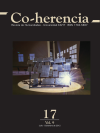Between reality and fiction : literary ekphrasis in Pedro Gómez Valderrama´s “El engañoso cuadro”
Main Article Content
Keywords
Literary ekphrasis, History, Mazepa, Gómez Valderrama, Pedro 1923-1992, Romanticism, Colombian authors.
Abstract
A panoramic exam toward Pedro Gómez Valderrama´s literary work, suggest a sporadic reference to the visual art. However a detailed assessment of it allows us to perceive that the writer set out in his writings a genuine look on the road to the art considering the relation among history-literature. This article expound an analysis of one of his stories in which it is possible to identify with clarity the artistic topic by means of literary ekphrasis. Thus, the paint of Mazepa it is referred and the way how the writer plays with the mythic ambiguity of the real character, making the most of both the historical aspect, the romantic nature of the pictorial and the literary construction.
Downloads
Download data is not yet available.
References
Alberto, Danilo (2007). La ecfrasis como mímesis. Buenos Aires: Insti-tuto de Altos Estudios sociales (IDAES), Universidad Nacional de San Martín.
Aristizabal, Alonso (1992). Pedro Gómez Valderrama. Bogotá: Procultura.
Beristáin, Helena (1998). Diccionario de retórica y poética (8ª ed.) México: Porrúa.
De’Angelo, Paolo (1999). La estética del romanticismo. Madrid: Visor.
Genette, Gerard (1989). Palimpsestos. La literatura en segundo grado. Ma-drid: Taurus.
Gómez Valderrama, Pedro (1996). Cuentos completos. Buenos Aires: Al-faguara.
Lessing, G. Ephraim (1985). Laocoonte. O los límites en la pintura y la poesía.Barcelona: Orbis.
Lozano-Renieblas, Isabel (2005). “La ecfrasis de los ejércitos o los límites de la enárgeia”. En: Monteagvdo, Vol. 3, No. 10, pp. 29-38.
Matos Moquete, Manuel (1999). “El poder y la silla”. En: Matos Moquete, Manuel. La cultura de la lengua. Santo Domingo: Instituto Tecnológico de Santo Domingo, pp. 17-20.
Montoya Campuzano, Pablo (2004). “Las utopías de Pedro Gómez Val-derrama”. En: Estudios de literatura colombiana, No. 15, Medellín, pp. 99-112.
Prada Oropeza, Renato (1989). “El narrador y el narratario: elementos “pragmáticos” del discurso narrativo”. En: Prada Oropeza, Re-nato (comp.) La narratología hoy. Ciudad de la Habana: Arte y literatura, pp. 346-396.
Riffaterre, Michael (2000). “La ilusión de ecfrasis”. En: Literatura y pintura.Madrid: ArcoLibros, pp. 161-183.
Redondo Sánchez, Carlos (2008). “La ecfrasis pictórica en la poe-sía de Irene Sánchez Carrón”. En: Extravío, revista digital de literatu-ra comparada, No. 3, p. 87-103. Tomado de: www. uv.es./extravío (fecha de consulta: septiembre 20 de 2009).
Robillard, Valerie – Jongeneel, Els (1998). Pictures into Words: Theoretical and Desciptive Approaches to Ekphrasis. Amsterdam: VU University Press.
Smyrniw, Walter (s.f.). “Hetman Ivan Manzepa in life and lite-rature”. Tomado de: http://www.uocc.ca/pdf/reflections/Maze-pa%20Life%20&%20Lit%20Final%20Draft%20web.pdf (fecha de consulta: septiembre de 2010).
Aristizabal, Alonso (1992). Pedro Gómez Valderrama. Bogotá: Procultura.
Beristáin, Helena (1998). Diccionario de retórica y poética (8ª ed.) México: Porrúa.
De’Angelo, Paolo (1999). La estética del romanticismo. Madrid: Visor.
Genette, Gerard (1989). Palimpsestos. La literatura en segundo grado. Ma-drid: Taurus.
Gómez Valderrama, Pedro (1996). Cuentos completos. Buenos Aires: Al-faguara.
Lessing, G. Ephraim (1985). Laocoonte. O los límites en la pintura y la poesía.Barcelona: Orbis.
Lozano-Renieblas, Isabel (2005). “La ecfrasis de los ejércitos o los límites de la enárgeia”. En: Monteagvdo, Vol. 3, No. 10, pp. 29-38.
Matos Moquete, Manuel (1999). “El poder y la silla”. En: Matos Moquete, Manuel. La cultura de la lengua. Santo Domingo: Instituto Tecnológico de Santo Domingo, pp. 17-20.
Montoya Campuzano, Pablo (2004). “Las utopías de Pedro Gómez Val-derrama”. En: Estudios de literatura colombiana, No. 15, Medellín, pp. 99-112.
Prada Oropeza, Renato (1989). “El narrador y el narratario: elementos “pragmáticos” del discurso narrativo”. En: Prada Oropeza, Re-nato (comp.) La narratología hoy. Ciudad de la Habana: Arte y literatura, pp. 346-396.
Riffaterre, Michael (2000). “La ilusión de ecfrasis”. En: Literatura y pintura.Madrid: ArcoLibros, pp. 161-183.
Redondo Sánchez, Carlos (2008). “La ecfrasis pictórica en la poe-sía de Irene Sánchez Carrón”. En: Extravío, revista digital de literatu-ra comparada, No. 3, p. 87-103. Tomado de: www. uv.es./extravío (fecha de consulta: septiembre 20 de 2009).
Robillard, Valerie – Jongeneel, Els (1998). Pictures into Words: Theoretical and Desciptive Approaches to Ekphrasis. Amsterdam: VU University Press.
Smyrniw, Walter (s.f.). “Hetman Ivan Manzepa in life and lite-rature”. Tomado de: http://www.uocc.ca/pdf/reflections/Maze-pa%20Life%20&%20Lit%20Final%20Draft%20web.pdf (fecha de consulta: septiembre de 2010).




